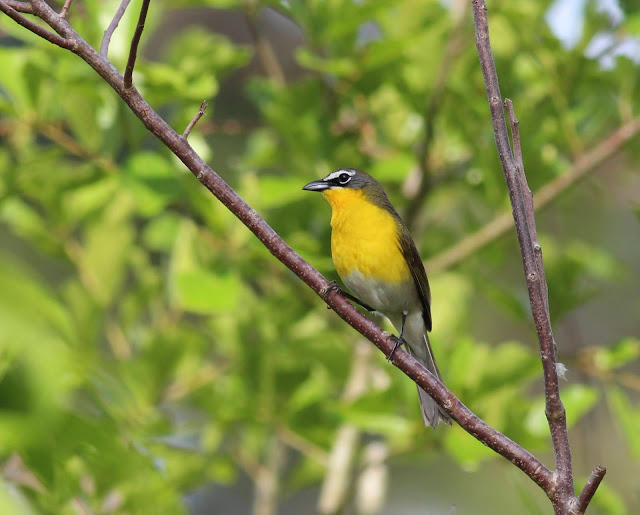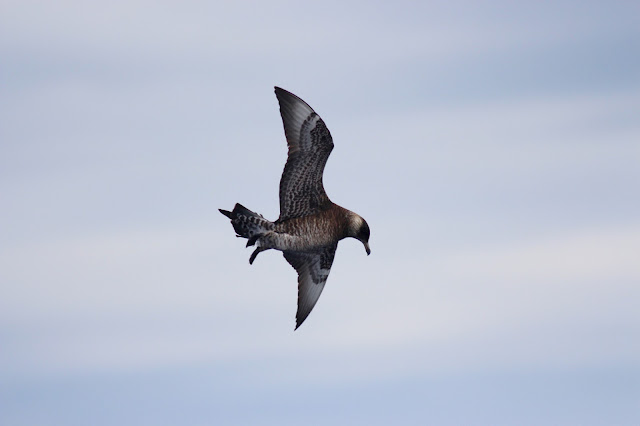I will try and refrain from making crude Booby jokes on this post because it has been done before. I believe I have seen all four of the American Boobies including Red-footed, Blue-footed and Masked. However, the photos I have of all them stink....until now. This particular bird has been hanging out in the same spot in Catawba County, NC and can be found in the exact same perch when he is not out foraging. Knowing this I vowed to go back with a boat of some sort to get better pictures. Here is the fruits of my labor taken from a small sit on top kayak.
Sunday, July 31, 2016
Wednesday, July 27, 2016
Blackburnian Warbler (Setophaga fusca) - 06May2016 & 22Jun2018
I have a theory. Any warbler with the word Black in the name is a good warbler. Black-and-white, Black-throated Blue, Black-throated Green, Black-throated Gray, Blackpoll and last but not least Blackburnian. Hmm, now that I think of it almost all warblers are cool.
I especially love Blackburnians because in North Carolina they breed at pretty high elevation and I usually find mine in beautiful spots like the Bald Knob Ridge Trail near Mt Mitchell which is also the highest mountain East of the Mississippi. That's where I found this bad boy.
Here is a pic from the other side of the parkway up by Pink Beds.
I especially love Blackburnians because in North Carolina they breed at pretty high elevation and I usually find mine in beautiful spots like the Bald Knob Ridge Trail near Mt Mitchell which is also the highest mountain East of the Mississippi. That's where I found this bad boy.
Here is a pic from the other side of the parkway up by Pink Beds.
Tuesday, July 26, 2016
Bobolink (Dolichonyx oryzivorus) - 13May2016
Everyone loves a Bobolink.
Per Wiki:
The bobolink breeds in the summer in North America across much of southern Canada and the northern United States. It migrates long distances, wintering in southern South America in Argentina, Bolivia, Brazil and Paraguay. One bird was tracked migrating 12,000 mi (19,000 km) over the course of the year, often flying long distances up to 1,100 mi (1,800 km) in a single day, then stopping to recuperate for days or weeks.
So this is a bird we have to get our fill of during a brief window in migration. In the Bahamas huge numbers of them can be seen flying through. The below male and female were captured on the Fort Fisher Spit in Kure Beach, NC.
Per Wiki:
The bobolink breeds in the summer in North America across much of southern Canada and the northern United States. It migrates long distances, wintering in southern South America in Argentina, Bolivia, Brazil and Paraguay. One bird was tracked migrating 12,000 mi (19,000 km) over the course of the year, often flying long distances up to 1,100 mi (1,800 km) in a single day, then stopping to recuperate for days or weeks.
So this is a bird we have to get our fill of during a brief window in migration. In the Bahamas huge numbers of them can be seen flying through. The below male and female were captured on the Fort Fisher Spit in Kure Beach, NC.
Monday, July 25, 2016
Spotted Sandpiper (Actitis macularius) - 17May2016
Per Wiki: The genus name Actitis is from Ancient Greek aktites, "coast-dweller", derived from akte, "coast", and macularius is Latin from macula, "spot". Spotted sandpipers nest on the ground. During each summer breeding season, females may mate with and lay clutches for more than one male, leaving incubation to them. This is called polyandry. Male parents of first clutches may father chicks in later male's clutches, probably due to sperm storage within female reproductive tracts, which is common in birds. Females that fail to find additional mates usually help incubate and rear chicks. "Prior to incubation, blood plasma concentrations of testosterone and dihydrotestosterone are substantially higher in males than in females" and these levels plummet 25-fold in males as incubation proceeds. Additionally, mated females have testosterone concentrations that are 7 times higher than those of unmated females.
I thought that was interesting.
In NC we have no problems finding these birds in migration. Find a body of salt or fresh water and usually you can find them on the edges bobbing up and down like a sandpiper in Delirium Tremens. Usually we don't see heavily spotted ones but I did manage to find the below bird in a puddle at the Battleship in Wilmington, NC.
I thought that was interesting.
In NC we have no problems finding these birds in migration. Find a body of salt or fresh water and usually you can find them on the edges bobbing up and down like a sandpiper in Delirium Tremens. Usually we don't see heavily spotted ones but I did manage to find the below bird in a puddle at the Battleship in Wilmington, NC.
Sunday, July 24, 2016
Pectoral Sandpiper (Calidris melanotos) - 07Oct2015 & 21Jul2016
The Pectoral Sandpiper is a fairly common bird during migration in NC but for whatever reason I do not see them much so I do study them when I get a chance. Most of them seem to bypass the coast as they seem to prefer fresh water habitats.
This first picture is from Falls Lake near Raleigh, NC.
The bird pictured below was one of the outliers and I found it on the North end of Wrightsville Beach. Or rather someone else found Pectorals on the beach a couple days in a row and so I went in search.
This bird was still in breeding plumage with a very dark delineation on the breast which made ID easy. The much more rare Sharp-tailed Sandpiper is the only similar bird possible in this area and it does not have such a stark delineation on the breast.
Yellow/orange bill and yellow legs are good field marks for this bird.
This first picture is from Falls Lake near Raleigh, NC.
The bird pictured below was one of the outliers and I found it on the North end of Wrightsville Beach. Or rather someone else found Pectorals on the beach a couple days in a row and so I went in search.
This bird was still in breeding plumage with a very dark delineation on the breast which made ID easy. The much more rare Sharp-tailed Sandpiper is the only similar bird possible in this area and it does not have such a stark delineation on the breast.
Yellow/orange bill and yellow legs are good field marks for this bird.
Yellow-breasted Chat (Icteria virens) - 15May2016 & 05May2019
Update from 2019: Here is the most cooperative Chat I have ever seen at Rogersville Rd in Wilmington.
Saturday, July 23, 2016
Pomarine Jaeger (Stercorarius pomarinus) - 20May2016
The Pomarine Jaeger known as Pomarine Skua outside of the Americas is a pirate of the high seas. It is the largest of the three Jaegers normally seen in NC waters (Parasitic, Long-tailed and Pomarine). Oddly enough it's mitochondrial DNA reveals it's closest relative is actually the Great Skua, although it looks morphologically more similar to the other Jaegers. From Wiki: "The word jaeger is derived from the German word Jager, meaning hunter. The genus name Stercorarius is Latin and means "of dung"; the food disgorged by other birds when pursued by skuas was once thought to be excrement."
The hunter of dung! Of course it is not dung they hunt but the partially digested food from other birds.
The dark brown morphs are the snazziest of the color morphs in my opinion.
All these pictures were taken on one of the Spring Blitz pelagics on Patteson's boat the Stormy Petrel II.
The central tail feathers are nicknamed "Spoons". You could eat a bowl of cereal with this particular bird's spoons.
The hunter of dung! Of course it is not dung they hunt but the partially digested food from other birds.
The dark brown morphs are the snazziest of the color morphs in my opinion.
All these pictures were taken on one of the Spring Blitz pelagics on Patteson's boat the Stormy Petrel II.
The central tail feathers are nicknamed "Spoons". You could eat a bowl of cereal with this particular bird's spoons.
Friday, July 22, 2016
Stilt Sandpiper (Calidris himantopus) - 21May2016
These pictures are from that magical day where a bunch of usually pretty skittish shore birds decided to have a pool party after a rain on the OBX. This particular ephemeral pool was at the Oregon Inlet Fishing Center. The birds were feeding voraciously only meters from my vehicle. Geri-birding at it's finest. These Stilt Sandpipers were also in their breeding plumage finery which made it extra special. Sibley's describes them as looking like Yellow-legs but feeding like Dowitchers with the up and down sewing machine action.
Thursday, July 21, 2016
Eastern Meadowlark (Sturnella magna) - 21May2016
Eastern Meadowlarks can be found many places in NC but I have one honey-hole that always produces photogenic Meadowlarks - Cape Hatteras Campground. Maybe the continuous stream of campers in this area have taught the birds they can coexist and not be shy. The below bird was particularly confiding.
Wednesday, July 20, 2016
Trindade Petrel (Pterodroma arminjoniana) - 22May2016
I am committed to getting better pictures of this wonderful species, but I could not wait to post at least something. In fact this is normally a species that is considered pretty difficult to find and some folks will take many pelagic trips out of Hatteras and never see one. I have been lucky enough to see 6-7 of them over the many pelagic trips I have gone on. Every sighting was fleeting and left me hungering for more. You need to be ready when a Trindade decides to show itself. All Gadfly Petrels are exceptional fliers that do not require any flapping of the wings to get around in an amazingly graceful and quick manner. They seem to like a stiff breeze and when they do come past the boat they use the wind to rocket past at very high speed and they don't typically hang out. The ones I have seen arced much higher in the sky than the other petrels and perhaps that is what gives them the bursts of speed. This is a species that nests on an island off the coast of Brazil!
Chocolatey goodness! I am always embarrassed when I botch the ID of a Sooty Shearwater as they have a similar color scheme which can confuse a newbie when the bird is flying by at mach 10 and you are trying to keep your footing on the forever shifting boat deck. This is why I love photography, you can quickly study your picture and confirm the ID. The Trindade's light patches under the wing are more distal in the primaries and of course the bill is smaller as in all Gadfly Petrels. I am slowly getting better at calling the birds and one day I hope to be able to shout one out in confidence that I have the ID correct.
Chocolatey goodness! I am always embarrassed when I botch the ID of a Sooty Shearwater as they have a similar color scheme which can confuse a newbie when the bird is flying by at mach 10 and you are trying to keep your footing on the forever shifting boat deck. This is why I love photography, you can quickly study your picture and confirm the ID. The Trindade's light patches under the wing are more distal in the primaries and of course the bill is smaller as in all Gadfly Petrels. I am slowly getting better at calling the birds and one day I hope to be able to shout one out in confidence that I have the ID correct.
Subscribe to:
Comments (Atom)

















































